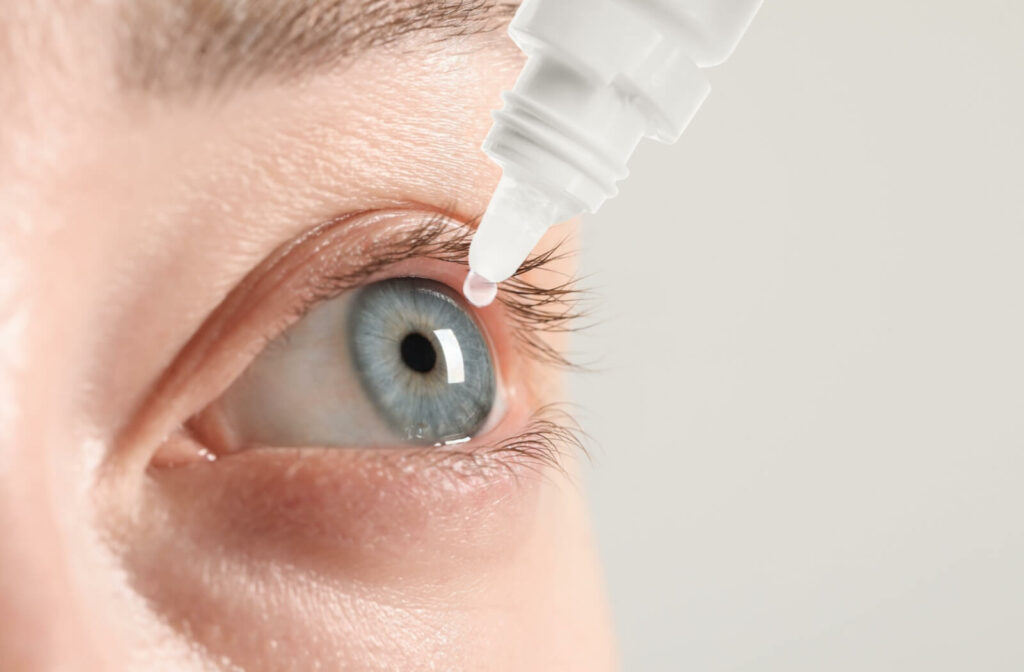Dry eyes can be a source of pain and irritation in our eyes, but could they also be contributing to the headaches you’re experiencing?
While dry eye doesn’t directly cause headaches, the strain that dry eye causes on the muscles around your eyes could cause tension headaches. In addition, some research suggests that damage to the nerves in your face can increase your risk of both dry eye and migraines.
Luckily, there are many dry eye treatments available to help soothe your dry eye symptoms and potentially reduce your risk of getting tension headaches.
What Is Dry Eye?
Dry eye syndrome, commonly called dry eye, occurs when your eyes don’t produce enough tears, or your tears evaporate too quickly. Tears are responsible for keeping the surface of your eyes hydrated, maintaining comfort, and helping clear vision. Without adequate moisture, your eyes can become inflamed and irritated.
Causes and Risk Factors
Several factors can contribute to dry eyes, including:
- Age
- Medical conditions
- Medications
- Dry air and wind
- Extended screen time and staring
- Contact lenses
Common Dry Eye Symptoms
Dry eye doesn’t always feel like your eyes are dried out, the symptoms can go beyond that. Here are some common symptoms of dry eye:
- A gritty or sandy sensation in the eye.
- Burning sensation in eyes.
- Redness
- Light sensitivity
- Feeling like something is stuck in your eye.
For those dealing with dry eyes and frequent headaches, these irritating symptoms can exacerbate discomfort, adding one more layer to the problem.
The Link Between Dry Eye & Headaches
What is the connection between dry eyes and headaches? Research increasingly shows that chronic dry eye syndrome is often associated with more frequent headaches or migraines. Although dry eyes don’t directly cause headaches, there’s a correlation between the two.
When your eyes are dry, you may squint or overwork them to see clearly. This excessive strain can fatigue the muscles around your eyes and forehead, leading to tension headaches.
Some research has shown a link between migraines and dry eye. This could be due to nerves in the eyes and face not functioning properly which can make people more sensitive to dry eye symptoms and to migraines when potential triggers are present.
When to Seek Help
If you’re experiencing symptoms of both dry eyes and headaches, then you need to know when to seek medical help. Dry eye symptoms, such as stinging, burning, and blurred vision, can sometimes coincide with tension headaches, which are commonly felt as pressure around the forehead and temples.
Keeping a symptom diary can be helpful. Documenting when your symptoms occur, how long they last, and any potential triggers can provide valuable information to share with your healthcare provider.
If your headaches persist or worsen, consult an eye care professional, who can assess whether they may be linked to your dry eyes and suggest appropriate treatment options.
Dry Eye Remedies & Treatments

If you suspect your dry eyes are a factor in your headaches, there are some things you can try to alleviate your dry eye symptoms.
Over-the-Counter Options
Artificial tears are widely used for treatments to moisturize and soothe dry eyes. But be careful as some eye drops have preservatives that can dry your eyes. Preservative- free drops are best. If allergies are contributing to your dryness, antihistamines can provide additional relief, but antihistamines can also make the dryness worse if you don’t hydrate enough. Pain relievers like ibuprofen or acetaminophen can help minimize the discomfort from headaches.
Prescription & Professional Treatments
If over-the-counter options aren’t cutting it, doctors may recommend prescription treatments to boost tear production and reduce inflammation in the eyes. Additionally, other in-office treatments, such as punctal plugs or Radio- Frequency and Intense Pulse-Light therapy, can provide long-term answers for chronic dry eye sufferers.
Home Remedies
Simple at-home measures can also alleviate dry eye symptoms:
- Warm compresses can stimulate tear production by unclogging any oil glands in your eyelids.
- Humidifiers can improve indoor air quality by preventing it from drying out your eyes.
- For headaches, consider cold compresses on the forehead or relaxation exercises like deep breathing to ease tension.
Prevention Tips
Preventing dry eyes and headaches before they occur is always better than finding remedies afterward. Incorporating a few changes into your lifestyle and environment can make a lasting difference.
Lifestyle Adjustments
- Reduce screen time, and when using screens, practice the 20-20-20 rule (look at something 20 feet away for 20 seconds every 20 minutes).
- If you wear contact lenses, follow proper hygiene guidelines and consider switching to glasses occasionally to prevent dryness.
- Stop staring at the screen. Blink more often.
Hydration & Diet
Staying well-hydrated supports healthy tear production, so drink plenty of water throughout the day. Incorporate foods rich in omega-3 fatty acids, like salmon, walnuts, and flaxseeds, into your meals. These nutrients help improve the quality of your tears, reducing evaporation. Also have your vitamin D levels checked as low levels can contribute to dry eye.
Environmental Changes
Small changes to your environment can minimize triggers for both dry eyes and headaches. Use a humidifier, especially during winter when indoor heating can dry out the air. Avoid direct exposure to air conditioning and fans, and opt for sunglasses that shield your eyes from sunlight and wind.
Take Control of Dry Eye & Headaches
Dry eyes and headaches—while seemingly unrelated—can significantly affect your comfort and quality of life. Understanding the connection between these conditions is the key to recognizing shared symptoms and finding necessary treatments.
At The Vision Place, we’re dedicated to delivering quality vision care. We have custom dry eye treatment options for you. Book an appointment today to see how we can help you find dry eye relief.


